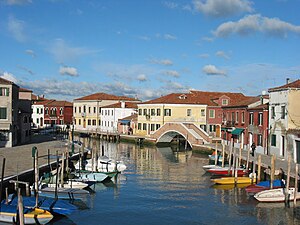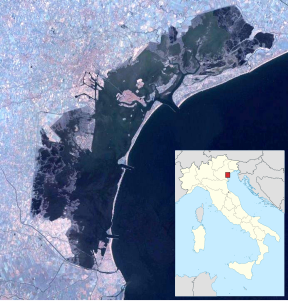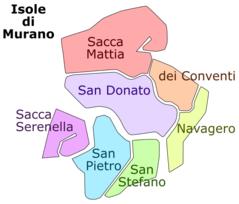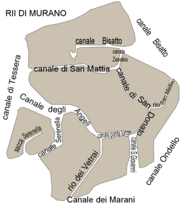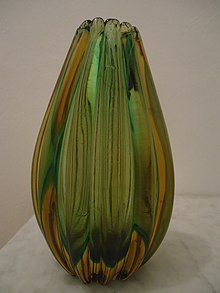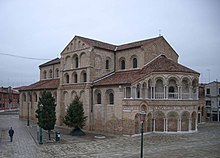Murano
| Murano | ||
|---|---|---|
|
Canale di San Donato main canal . The Rio San Matteo joins from the right . The mouth is spanned by the Ponte San Martino . |
||
| Waters | Venice lagoon | |
| Geographical location | 45 ° 27 '30 " N , 12 ° 21' 5" E | |
|
|
||
| surface | 1.171 625 km² | |
| Residents | 4683 (2009) 3997 inhabitants / km² |
|
| Waterfront | ||
Murano , Venetic Muran is an archipelago northeast of the historic center of Venice in the Venice lagoon . It is known for its glass art, but also lives from tourism and - to a much lesser extent - from fishing.
Its roots go back to late antiquity. In the 5th and 6th centuries the population increased due to refugees from Altinum who sought protection from the Huns and Lombards . At the end of the 13th century, glass production was concentrated here, which was on the decline towards the end of the Republic of Venice . In the course of the 19th century there was a revitalization, which was supported by the municipality. Murano has been part of the city of Venice since 1924.
geography
Murano is 1.1 km north of Cannaregio (part of the old town of Venice) and 230 meters north of the cemetery island of San Michele . The total area is 1.17 km² (more precisely 1,171,625 m²), with 4,683 inhabitants (as of August 19, 2009). The archipelago only reaches a height of one meter. According to the city of Venice, however, the area is 1,531,322 m². / L / IT / IDPagina / 36137
The group consists of seven individual islands, which are separated by eight canals and connected by eleven bridges.
The wider Canal Grande di Murano (which is subdivided from west to east into Canale degli Angeli, Canale Ponte Lungo and Canale San Giovanni) divides Murano into two subgroups. The northern group includes the islands of Sacca Mattia, a still little developed, artificial island, then the main island of San Donato, plus S. Teresa e S. Mattia and S. Giacomo e S. Maffio. The southern group includes the three islands Sacca Serenella, the second artificial island, then San Pietro Martire (with the Palazzo da Mula ) and S. Chiara e Santo Stefano, where the faro , the lighthouse is located.
Similar to Venice, Murano has a series of canals spanned by bridges that connect the islands together. The Ponte Ballarin o de Mezo spans the Rio dei Vetrai, the two bridges Ponte delle Terese and Ponte San Donato the Canale San Donato, the Ponte San Martino spans the Rio San Matteo, the two bridges Ponte San Pietro Martire and Ponte Santa Chiara Rio dei Vetrai, the Ponte Longo o Vivarini the Grand Canal (also Canale Ponte Longo) and finally the Ponte del Campo Sportivo the Canale di San Mattia.
| island | Area m² |
Population 2009 |
Remarks |
|---|---|---|---|
| Sacca Mattia | 411,863 | 7th | artificial island, still little developed |
| San Donato | 349,570 | 1776 | Main island |
| S. Teresa e S. Mattia | 129,850 | 1224 | with San Giuseppe |
| S. Giacomo e S. Maffio | 122,259 | 268 | with San Matteo and the Palazzo Trevisan |
| Sacca Serenella | 159.975 | 18th | artificial island |
| San Pietro Martire | 219.919 | 969 | with the Palazzo da Mula |
| S. Chiara e S. Stefano | 137,886 | 450 | with the lighthouse |
| Murano | 1,531,322 | 4,712 |
The three islands south of the Canal Grande di Murano , namely San Pietro Martire, Santo Stefano and Sacca Serenella, as well as the western part of the main island San Donato with the subsidiary church Santa Maria degli Angeli belong to the parish of San Pietro di Murano. The remaining areas belong to the parish of San Donato di Murano.
history
Late antiquity and early Middle Ages
Canals ( fossae ) already existed in the Roman Empire , which, like the fossa Clodia , reached as far as Chioggia . They allowed boats to go to Pellestrina , Poveglia and Malamocco . So the traffic from Ravenna could reach over these waterways to San Pietro di Castello , Murano, San Giacomo in Paludo and Torcello or Altinum . The remains of two guard posts from the 3rd and 4th centuries were found north of Murano.
Pottery was found from the late 4th to the middle of the 6th century at what is now the Museo Vetrario , the museum for the art of glassmaking. At the end of the 6th century, refugees came from the mainland to Torcello and Murano, but also to other islands. Around 600 the island had to struggle with the rising water level of the lagoon, in the 7th and 8th centuries the landfill began. When the neighboring Torcello had to be gradually abandoned by the 12th century, many of the residents moved to Murano.
Salt production played a major role in the 11th century. In the period from 1000 to 1049 of the twelve fondamenti , the systems for salt extraction in the lagoon, five were near Murano.
Renaissance, glass production
The ancient glass production in the Roman Empire was interrupted by the great migration . Presumably through the trade with Byzantium , where the technology was not lost, it came back to Central Europe via Venice. Venice can therefore be seen as the cradle of Central European glass production. The oldest document that mentions a fiolario is from 982.
For fire protection reasons, all glass furnaces were relocated from Venice to this island in 1295 . Above all, however, this measure served to keep the closely guarded secret of glass production . The well-paid glassblowers were forbidden to pass on their knowledge on pain of death. Nevertheless, the recognition of the patent law that arose in the 15th century was not a matter of course. The glassmaker Giorgio Ballarin stole some recipes from Angelo Barovier, the inventor of various dyeing methods and the cristallo , and revealed them to his future father-in-law. Ballarin then became one of the most successful glassmakers on Murano. Since the 13th century, the glassmakers had statutes, which were reformed in 1441 and also transferred in Volgare, in the Venetian vernacular. These statutes were called Mariegole .
During the Renaissance , the ornate glass products of the colorless Venetian cristallo became the main source of income for the population. Little is left; the multitude of shapes and decors is revealed above all from the depictions on still lifes . Despite all attempts by the Republic of Venice to keep the technology of glass production and refinement a secret, at the end of the 16th and 17th centuries a few glassblowers succeeded in emigrating to the countries north of the Alps and setting up glassworks there. Above all, the poaching attempts by Louis XIV were decisive, as he was able to fulfill his dream of the hall of mirrors . As a glass à la façon de Venise , the Venetian style lived on in Germany, the Netherlands and Flanders, where other rich collections have been preserved. The Venetian supremacy in glass production was only broken in the 18th century by the success of baroque cut glass, because the Venetians did not master this technology, which was mainly found in Bohemia and Silesia, but increasingly also elsewhere in Germany.
The monastery church of San Cipriano Dogen served as a burial place in at least two cases. Pietro Polani was buried there in 1148, as was the Doge Pietro Gradenigo in 1311 . The church was abandoned in 1817 and thus left to be destroyed. In 1837 it was sold and systematically demolished, so that today nothing reminds of the building.
When the sestieri were reorganized in the 1170s, Murano was initially added to the sestier Santa Croce. From the late 13th century, the island was under a Podestà. In 1581 at the latest, but probably much earlier, the island received the right to mint its own medals once a year based on the model of Venetian coins (the oselle) and to hand them over to their magistrates. In 1924 the island was incorporated into Venice against the resistance of the population. This led to riots.
Tourism, resurgence of glass art, museum
Only with the beginning of tourism at the beginning of the 19th century did Murano flourish again. The historicism in Venice, initiated by the establishment of a glass school in Murano in 1860 and the founding of the company Società Salviati & Co. by Antonio Salviati in 1866, tied aware of the glass art of the Renaissance, with its thin wings glasses, thread and network glasses (Reticella) again . The Fratelli Toso stand for Art Nouveau in millefiori decors, achieved by melted murrine . Venetian glass vessels from the 1950s and 1960s are based on expressionism in terms of color and decor . Extremely colorful stripes and geometric Op Art decors in vetro pezzato technique are typical for the designs of Paolo Venini , Fulvio Bianconi and Ercole Barovier ; Ercole Barovier's son Angelo explicitly refers to Vasarely in some of his designs . Plain colored vessels with various undertakings (in vetro sommerso) by Flavio Poli are also part of the repertoire of the Venetians of the 20th century.
The thousand-year history of glass production is documented in the Museo Del Vetro in the Palazzo Giustinian on Murano with vases, mirrors and drinking vessels. One of the three large ceiling lights in the entrance area is an award-winning work by Fratelli Toso, which was contributed to the opening of the museum in 1854. In 1861, Antonio Colleoni (1811–1855), the island's mayor, and the abbot Vincenzo Zanetti (1824–1883) set up an archive to preserve the island's archives and make them accessible to the public. Zanetti set up a glassmaking school right next to the archive, where the old techniques were taught. After the island was incorporated into Venice, the local museum was under the Musei Civici Veneziani. The technology with which the Murano glass is produced is only mastered by the glass manufacturers from Murano.
Today the streets of the island are characterized by a large number of glass shops and Murano glass has become a popular collector's item. A clear distinction must be made between glass galleries, in which contemporary works by Venetian studio glass artists are exhibited and available, and tourist souvenir shops that sell mass-produced glass objects.
Attractions
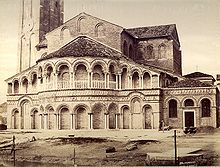
A well-known church in Murano is the Basilica di Santi Maria e Donato from the 12th century with its colorful mosaic floor from 1140 and the free-standing square campanile . It was formerly the cathedral of the bishops of Torcello and Murano.
The actual entrance side of the basilica faces west according to the order. With this church located directly on the canal, the aim was less to impress the locals than the arriving guests, who mostly came from the east via the Rio San Matteo. This is why this east side of the church, i.e. the choir area, is the actual viewing side. These of the Blessed Mother and St. Donatus church is one of the oldest structures in the whole lagoon. It was built in the 7th century, later rebuilt in the 9th and 12th centuries and completed in its current form in 1140.
The choir room in particular is very representative; A two-storey arch construction was erected with striking white columns. The arcade structure of the first floor is repeated in the gallery on the first floor. Very similar arches run around the entire front on several floors, either as a walk-in gallery or as a window frame or as a series of arcades that are only faded in.
The interior of the basilica is famous for its elaborate floor mosaics from the mid-12th century. The colorful Venice has developed a great sense for delicate decoration in this area. The semi-dome of the apse area shows the solitary figure of the Madonna on a golden mosaic base, just like in Torcello, based on the Byzantine model.
In addition to Santa Maria e Donato , Murano has another church worth seeing, namely the church of San Pietro martire , built in 1348 as a Dominican monastery church and renovated after the fire of 1474, reopened in 1511 , which today serves as a Protestant parish church. The former monastery of Santa Maria degli Angeli was converted into a hospital after secularization. Various works of art from the former interior can be found in the Murano Glass Museum.
A memorial commemorates the Italian writer Italo Svevo (originally Hector Aron Schmitz ; known as Ettore Schmitz ), who lived on Murano from 1898 to 1916, where he ran his in-laws' factory and produced underwater paints. The memorial contains a glass object and a bronze plaque with a quote from Italo Svevo.
One of the last representatives of the villas that used to be common on Murano is the Palazzo da Mula , which dates back to the 14th century.
traffic
Murano can be easily reached from Venice by vaporetto . Circolare No. 41 goes from Murano to San Michele, then heads for Fondamenta Nove, Venezia Santa Lucia train station , Piazzale Roma , Giudecca , S. Zaccaria and then returns to Murano via Fondamenta Nove. Diretto Murano (DM), on the other hand, heads for Murano directly from the car park and the train station with five intermediate stops.
Sports
Murano has a small stadium with a field of 105 × 60 m, which is intended for 250 visitors and was built for the local club AC Muranese and a few other teams. AC Muranese was founded in 1929 and merged with ASD Laguna di Venezia after 80 years.
literature
- Attila Dorigato: Glass Art in Venice . In: Venice, Art & Architecture , Romanelli, Giandomenico (Ed.), Vol. 2, Cologne 1997, pp. 790–797.
- L. Vianello: Una gemma delle lagune. La storia di Murano , Venice 1912.
- Vincenzo Zanetti: Guida di Murano e delle celebri sue fornaci vetrarie , Venice: Forni 1984.
- Sergio Barizza, Giorgio Ferrari: L'Archivio municipale di Murano 1808/1924 , Portogruaro: Cooperativa Nuova Dimensione editrice 1990.
- Aldo Bova, Attilia Dorigato, Puccio Migliaccio, Vladimiro Rusca: Vetri artistici. Antonio Salviati, 1866–1878 (Museo del vetro di Murano, 1), 2008.
- Silvano Tagliapietra: Cronache muranesi 3: il tempo della Muran Nova 1951–1975 , Helvetia, 1990.
- Silvano Tagliapietra: Murano dalla "Marsigliese" alla "Bella Gigogin". l'Ottocento , Helvetia, 1985.
- Silvano Tagliapietra: I muranesi nel Settecento , Helvetia, 2002.
- M. Bortoletto: Murano: Mazzorbo e Torcello. Tre siti a confronto , in: Archeologia delle Acque 1/1 (1999), pp. 55-74.
- Mario De Biasi: La fine dell'autonomia di Murano, 1924 , Associazione per lo studio e lo sviluppo della cultura muranese, Murano 1994.
Movie
- Murano. Documentary, Germany, 2003, 30 min., Script and director: Birgit Kienzle, production: SWR , film information from 3sat .
Web links
- Museo del Vetro
- Detailed map of Murano
- Map of the island and its surroundings , Istituto Geografico Militare
- Information pages about the famous Murano glass , design-and-arts
- Ss Maria e Donato
Remarks
- ↑ veniceinitaly.com, Venice islands: All the islands of Venice by area ( Memento of March 24, 2009 in the Internet Archive )
- ↑ Basi territoriali al censimento 2001
- ↑ Parishes in Cannaregio-Estuario ( MS Word ; 54 kB)
- ^ M. Bortoletto: Murano, Mazzorbo e Torcello. Tre siti a confronto , in: Archeologia delle Acque 1/1 (1999) 55-74, here: p. 62.
- ^ Jean-Claude Hocquet: Le Saline, in: Storia di Venezia , vol. I: Origini-Età ducale Lellia Cracco Ruggini , M. Pavan, Giorgio Cracco , Gherardo Ortalli (eds.), Rome 1992, pp. 515-548, here: pp. 518-520.
- ↑ Venezia e le sue lagune , Vol. I, Part II: Zecca e monete di Venezia , Venice: Antonelli 1847, p. 70. List and illustrations
- ↑ Storie di Murano. I Tumulti del 1923-1924 , L'Isola website .
- ↑ La storia del ASD Laguna Di Venezia ( Memento of the original from April 2, 2015 in the Internet Archive ) Info: The archive link was inserted automatically and has not yet been checked. Please check the original and archive link according to the instructions and then remove this notice. .
